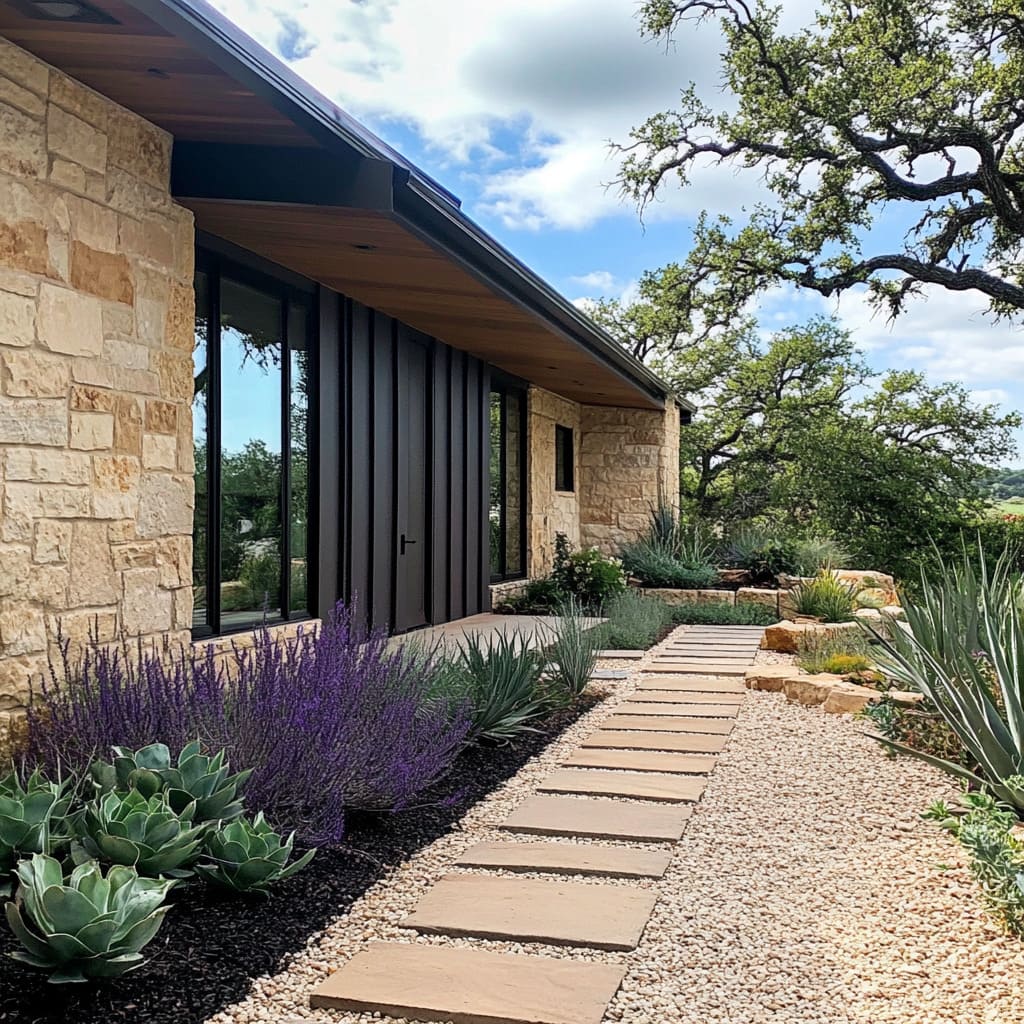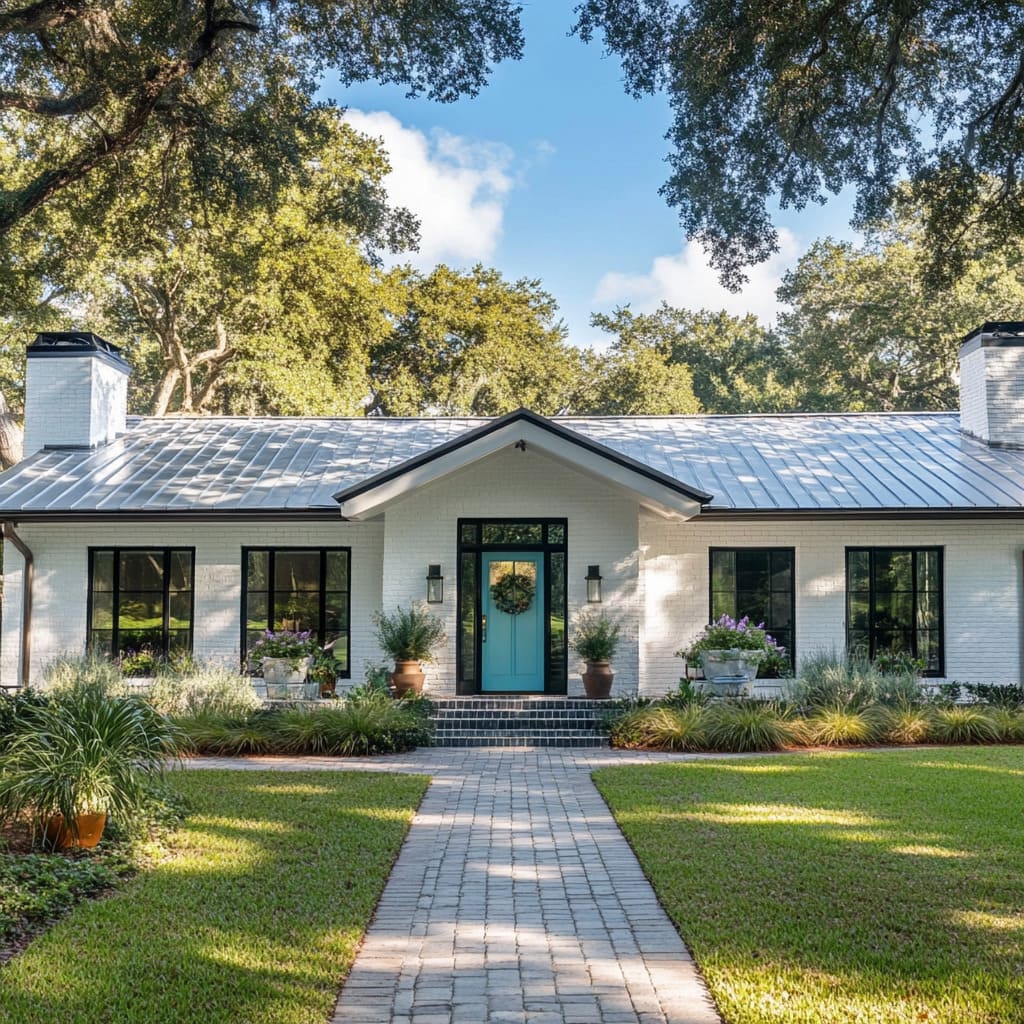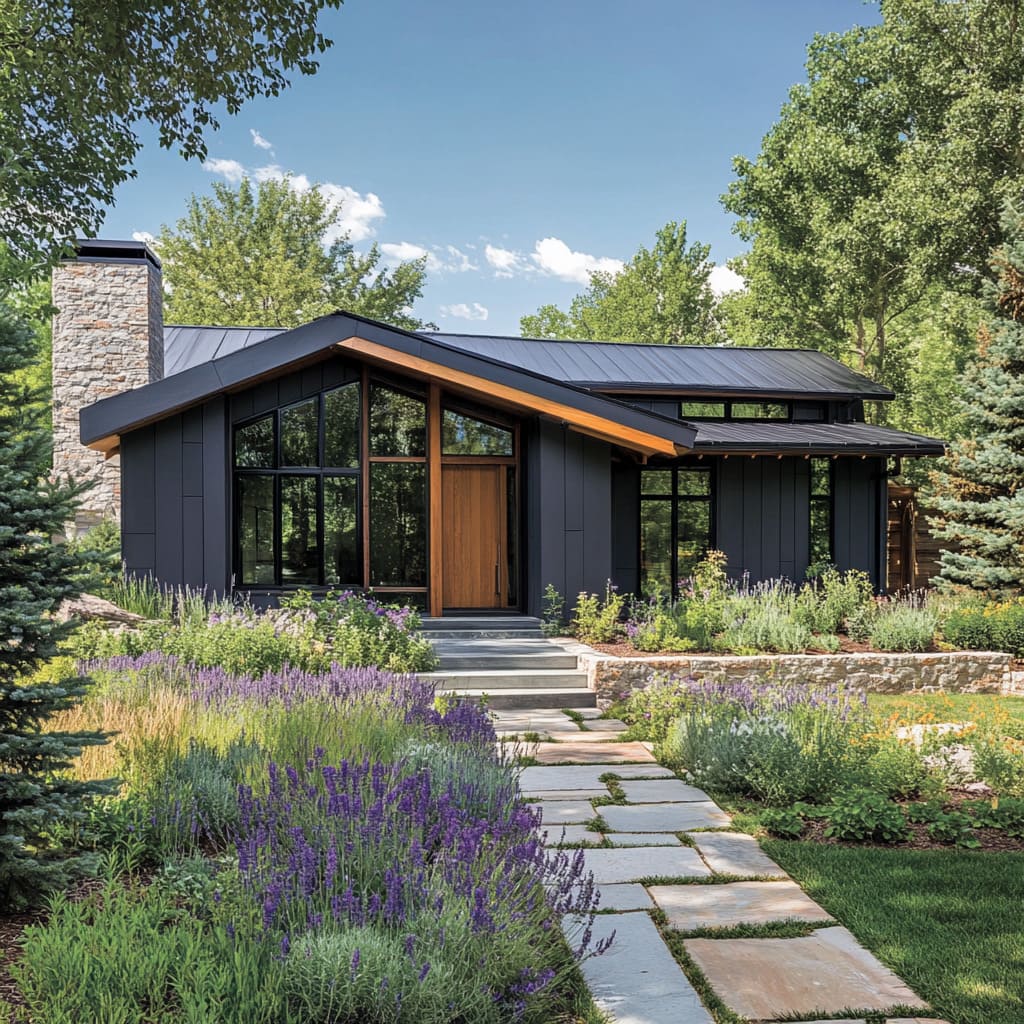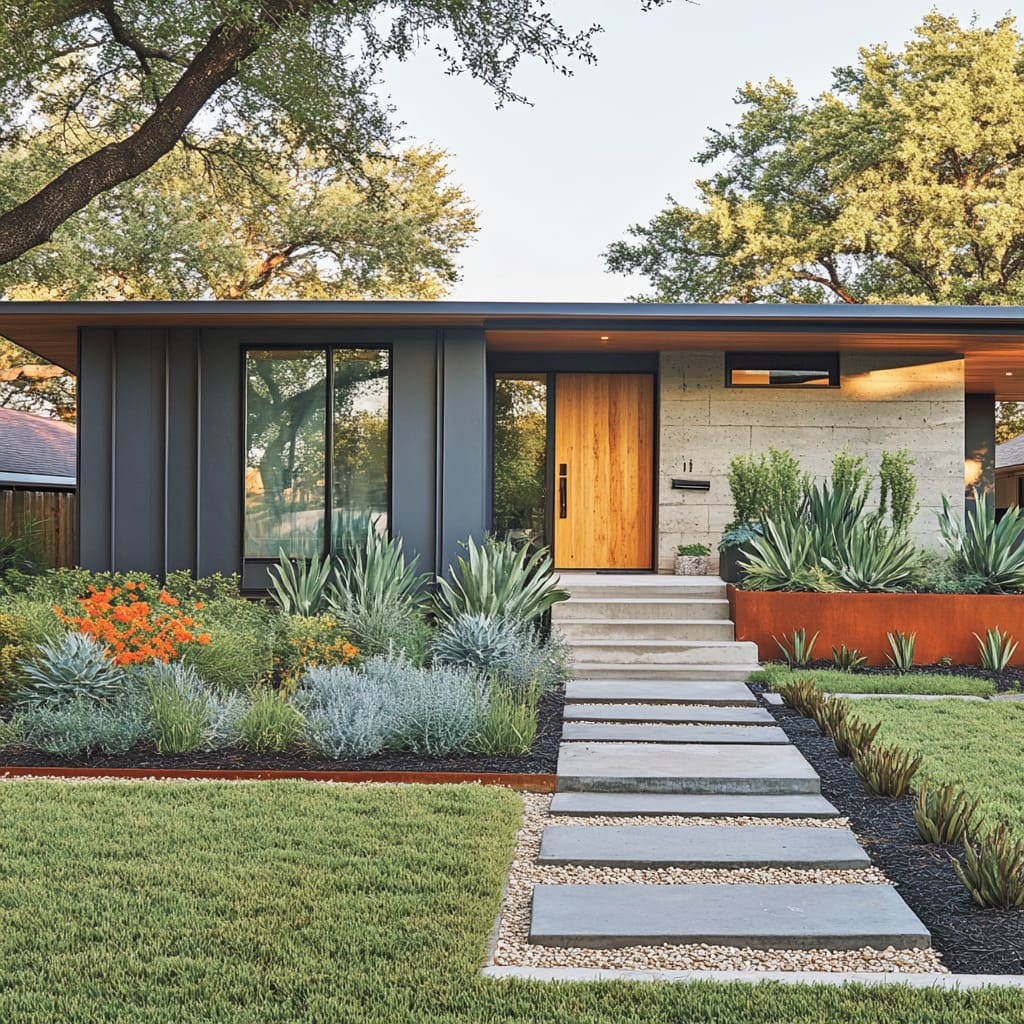Ranch-style homes have always been a staple of timeless architecture, celebrated for their clean lines, single-story layouts, and seamless blend with nature. However, modern ranch home designs are pushing creative boundaries, transforming these classic homes into striking, updated exteriors that feel fresh, stylish, and functional.
By combining smart design choices, carefully selected materials, and intentional landscaping, today’s ranch homes are redefining their aesthetic without losing their charm.
This article takes a deep dive into the design features and ideas that make ranch house exteriors truly stand out. From bold combinations of contrasting materials like natural stone and dark steel to landscaping that feels thoughtfully connected to the architecture, these homes prove that every small decision contributes to a harmonious overall look.
We’ll explore how subtle elements—like window placements, front door details, or pathways—enhance the visual flow and create balance. Whether you’re inspired by the natural colors of the Southwest or the crisp, modern tones of urban suburbs, the designs here are filled with insights that can help transform a ranch home into a showstopper.
The magic often lies in the unexpected combinations—rough textures meeting sleek finishes, dark hues balanced with greenery, and modern details grounded in traditional forms. Stay tuned as we unpack the thoughtful details and design principles shaping today’s most stylish ranch exteriors.
Harmonizing Material Contrasts for Balance
One of the standout features in modern ranch house style homes is the thoughtful use of contrasting materials to achieve balance, depth, and a refined visual appeal. The beauty of these designs lies in how they seamlessly mix textures and tones to create homes that feel striking yet grounded.
For instance, the combination of dark matte brick with warm wood paneling delivers a sleek, modern look while maintaining a natural touch. The industrial strength of brick is softened by the organic texture of wood, resulting in a design that feels sturdy yet inviting.
Another key design choice is pairing light stone facades with dark window frames. This contrast sharpens the home’s overall appearance, offering a modern twist to the classic ranch silhouette.
The crisp edges of dark trim enhance the natural hues of stone, ensuring the home’s exterior feels both clean and dynamic. This design works particularly well in homes where natural light can play off the lighter materials, amplifying the contrast without overwhelming the design.
Pathways also play a significant role in adding contrast to ranch-style homes. Slate or gravel walkways, often set against wildflower beds or lush greenery, blend raw natural elements with polished architecture.
The rugged textures of stone or gravel are softened by surrounding plants, creating a natural rhythm that draws the eye toward the house while adding interest to the landscape. This approach not only enhances curb appeal but also grounds the home within its environment, making it feel connected to the surrounding space.
The real design insight here is the balance between contrasts. Without careful attention, a home can feel flat or uninspired.
By thoughtfully combining opposing materials—whether it’s light and dark, smooth and textured, or industrial and organic—each element is allowed to shine. Focal points emerge naturally, breaking up visual monotony and adding dimension.
Ultimately, these contrasts give the exterior its character, pulling the entire design together into a cohesive, polished look.
Use of Color as a Structuring Element
In a modern ranch style house, color isn’t merely decorative—it serves as a deliberate tool to highlight, balance, and organize the overall design. Dark facades, such as charcoal or matte black, bring bold sophistication to the home’s exterior.
To prevent the darker palette from feeling too heavy, warm wood tones are strategically incorporated in elements like exposed beams, wooden doors, and paneling. This natural material softens the starkness, providing an organic contrast that keeps the home visually appealing and grounded.
The result is a contemporary and refined look that feels both welcoming and modern.
For lighter exteriors, sharp contrasts are introduced through black-framed windows and doors. These accents add definition and clean lines, keeping the structure visually structured and streamlined.
The use of black trim punctuates the softness of white or light-toned facades, ensuring the home maintains a crisp, well-defined shape. This technique draws attention to key architectural features without overwhelming the simplicity of a light color palette.
Landscape design plays a complementary role in tying the entire exterior together. Natural colors from elements like lavender, ornamental grasses, and trees bring life and movement to muted facades.
These subtle pops of green, purple, and gold add vibrancy to the overall design while blending seamlessly into the home’s natural surroundings. The organic hues enhance curb appeal without clashing with the home’s structured palette, keeping everything balanced and intentional.
The insight lies in the thoughtful placement of colors to guide the eye naturally across the home’s facade. Darker tones anchor the house, giving it a solid foundation, while lighter hues act as highlights that emphasize focal points like doors, windows, and architectural details.
This careful application not only enhances the home’s visual structure but also creates a sense of harmony, ensuring the design feels complete and cohesive. By treating color as a structuring element, the exterior achieves a refined yet dynamic balance that leaves a lasting impression.
Integration of Rooflines to Enhance Design Flow
Rooflines in a contemporary ranch style home are far more than functional—they serve as key elements that define the home’s character and flow. Flat roofs or gently sloped designs are a hallmark of mid-century modern influences, creating clean horizontal lines that stretch the house visually.
This technique emphasizes the low, elongated profile typical of ranch homes, while lending a sleek and modern touch. These subtle rooflines enhance the home’s minimalist aesthetic, making it feel connected to the surrounding landscape.
For those who prefer a more rustic interpretation, gabled roofs are a perfect addition. When paired with exposed wooden trusses, they introduce a natural and farmhouse-inspired element without disrupting the simplicity that defines ranch home architecture.
The visible timber details add texture and warmth, showcasing craftsmanship while blending the structure seamlessly with its outdoor setting. Whether stained for a rich tone or left in their natural hue, these trusses become standout features that elevate the roofline’s design appeal.
Overhangs, often extending far beyond the walls, serve dual purposes. They provide much-needed shade in sun-drenched areas, improving energy efficiency and comfort within the home.
At the same time, they visually connect indoor and outdoor spaces, reinforcing the ranch home’s signature connection to nature. These extended eaves create covered patios, breezeways, and entryways, transforming functional features into architectural highlights that enhance the flow and usability of the design.
The choice of roofline ultimately shapes the home’s proportions and personality, particularly in single-story layouts. Flat or low-pitched roofs lend a contemporary edge, making the home feel anchored and modern.
On the other hand, gabled structures maintain a timeless look, offering opportunities to incorporate decorative details such as trusses, rafters, or accent lighting. By carefully selecting and integrating rooflines, designers create homes that feel balanced, intentional, and perfectly aligned with the ranch aesthetic.
The result is a seamless harmony between form and function, where every line contributes to the overall flow of the design.
Pathway and Landscape Integration
Pathways and landscaping are critical components in tying together the ranch house exterior ideas, elevating the visual appeal while enhancing functionality. Stepping stone pathways offer an organic approach, where large, clean-cut stones are laid over gravel or pebbles.
This design choice balances structure with a natural flow, especially when the pathways are framed by soft wildflowers, succulents, or ornamental grasses. The irregularity of the stones combined with the untamed greenery adds a grounded charm, effortlessly blending with the ranch home’s approachable style.
Pathways are intentionally designed to guide visitors through the landscape and highlight key architectural features. Whether leading to a prominent wooden front door, a patio with warm accents, or a garden sculpture, the placement of pathways creates a clear sense of arrival.
The visual flow these walkways establish helps emphasize focal points within the design, ensuring that the home’s exterior feels cohesive and intentional. For homes with wooden paneling, pathways framed with low greenery like lavender or creeping thyme add softness while enhancing the home’s natural tones.
Layered landscaping is another standout feature that adds richness to the exterior. A combination of ground covers, mid-height perennials, and taller shrubs or trees creates dimension and texture.
This layered approach not only draws the eye upward but also establishes natural boundaries around pathways, framing the house in a way that feels both lush and polished. Incorporating native plants or drought-resistant species is a popular choice for areas with warmer climates, reflecting an eco-friendly and low-maintenance aesthetic.
The contrast between structured hardscaping and freeform landscaping is a key design principle that makes ranch exteriors shine. Clean-lined pathways provide balance against wilder, more textured planting beds, creating a natural meets geometric look.
This combination reinforces the ranch home’s signature indoor-outdoor connection, where the home feels fully integrated into its surroundings. Thoughtfully planned pathways do far more than serve as practical walkways—they transform the yard into an extension of the home, offering a clear, visually satisfying journey through the design.
Thoughtful Placement of Windows to Merge Indoors and Outdoors
Windows are a defining feature of modern ranch style homes exterior, bridging the divide between inside living spaces and outdoor landscapes. Oversized windows, especially floor-to-ceiling designs, amplify natural light and create a seamless flow between the interior and exterior.
These expansive glass panes remove visual barriers, transforming the outdoors into an extension of the home. Whether framing a lush garden, wooded grove, or an open lawn, large windows make every view feel intentional, giving the house a sense of balance with its surroundings.
The choice of black-framed windows brings a bold, modern edge to the ranch home’s design. By emphasizing clean lines and geometric forms, these dark accents highlight the home’s horizontal structure, a hallmark of ranch-style architecture.
Black frames provide a sharp contrast against lighter facades—whether in stone, whitewashed brick, or stucco—drawing attention to the windows as both functional and decorative elements. In homes with darker exteriors, these frames seamlessly blend in, creating a sleek and unified appearance.
Strategically placed windows also serve to reflect the natural surroundings, creating a visual harmony between the home and the landscape. This reflective quality is especially effective in wooded or scenic areas, where the glass mirrors trees, sky, and greenery, making the structure feel deeply connected to its environment.
In addition, windows that open onto patios or gardens further emphasize the ranch home’s focus on indoor-outdoor living, a feature that remains timeless and practical.
Beyond aesthetics, windows bring practical benefits by maximizing natural light and reducing reliance on artificial lighting. Thoughtful placement—like positioning larger windows in communal spaces such as living rooms and kitchens—ensures these areas feel bright, open, and connected to the outdoors.
Smaller windows in private spaces, such as bedrooms, maintain intimacy while still inviting natural light. The result is a cohesive design where the placement and style of windows enhance both the beauty and functionality of the home.
Innovative Placement of Decorative and Structural Accents
Decorative and structural accents play a key role in shaping contemporary ranch house exteriors, blending function with visual appeal. Wooden beams, often seen under gabled roofs, serve as architectural highlights that ground the home’s design.
These beams add warmth and dimension to the structure, balancing the clean lines of modern facades with organic texture. Whether left exposed in a rustic finish or refined with smooth detailing, they act as focal points, drawing the eye upward to emphasize rooflines.
Strategically placed wall sconces enhance the symmetry and aesthetic flow of entryways or under roof eaves. These sleek lighting elements provide both function and style, offering soft, ambient illumination in the evening while highlighting key architectural features.
Sconces flanking entry doors lend a polished and inviting look, creating a sense of balance and completion in the design. When paired with modern materials like dark brick or wood paneling, lighting elements soften the home’s overall feel while maintaining a contemporary edge.
Natural stone accents, such as chimneys or feature walls, introduce rugged texture to sleek, modern exteriors. These stone details act as grounding elements, adding visual weight and organic character that offsets minimalist materials like smooth siding or dark paneling.
A stone chimney, for example, provides contrast against matte finishes while reinforcing the ranch house’s timeless connection to nature. When used sparingly, these accents prevent the facade from feeling too stark, instead adding a balanced and layered appeal.
The combination of structural features and decorative details transforms functional elements into design statements. Wooden beams, chimneys, and lighting fixtures work together to break up large, flat surfaces and emphasize architectural symmetry.
This thoughtful integration ensures that each accent feels intentional, enhancing both the structure’s style and functionality. The result is a visually cohesive design where decorative and structural elements contribute to the overall character of the home, making it stand out while still blending harmoniously with its surroundings.
The Power of Natural and Sustainable Design
Natural and sustainable design has become a defining feature when exploring exterior ideas for ranch style homes, blending eco-conscious choices with timeless aesthetics. Homeowners are turning to drought-tolerant plants like succulents, lavender, and ornamental grasses that require minimal maintenance while thriving in various climates.
These plants not only reduce water usage but also introduce texture, soft color, and movement into the landscape. Whether lining pathways or filling garden beds, they seamlessly enhance the home’s connection to its environment.
Stone, gravel, and wood are favored for their durability and organic appeal. Gravel pathways and stone accents ground the design, offering practical solutions for foot traffic while complementing the natural surroundings.
Weathered wood elements—seen in fencing, soffits, or porch details—age gracefully over time, blending effortlessly into their setting. These choices reinforce the idea that materials should not fight against nature but work with it to create a cohesive and functional space.
Wildflower gardens and unstructured plant beds are another smart addition to ranch exteriors. These natural, free-flowing designs soften the sharp architectural lines often seen in modern ranch homes.
Unlike overly manicured lawns, wildflower meadows and native plants bring a relaxed charm, attracting pollinators like butterflies and bees while adding vibrant, seasonal color. This approach creates a dynamic landscape that feels alive and evolving, enhancing the home’s connection to the outdoors.
The beauty of incorporating natural and sustainable elements lies in their ability to shape both the visual appeal and functionality of the design. These materials and plants ensure the home feels rooted in its location, whether surrounded by open plains, wooded groves, or suburban landscapes.
Sustainability is not just a trend—it’s a design principle that adds lasting value, making ranch homes both beautiful and environmentally responsible for years to come.
Principles in Combining Materials and Textures
The most impressive exterior updates for ranch style homes often come from unexpected but thoughtful combinations of materials and textures. Pairing matte finishes on brick or stone with polished wood creates a tactile contrast that adds depth and interest.
For instance, smooth cedar panels against a textured brick façade give the exterior a modern edge while maintaining a warm, inviting appeal. This combination balances rugged and refined finishes, ensuring that no single material dominates the design.
Hardscaping, like stone or slate pathways, offers another opportunity to blend textures creatively. By combining structured, geometric hard surfaces with softer elements like wildflowers, creeping thyme, or ornamental grasses, designers avoid visual monotony.
The hard and soft interplay creates movement and balance while reinforcing the home’s connection to nature. This principle is particularly effective in ranch-style homes, where outdoor spaces are extensions of the architecture.
Cohesion is achieved through repeated design features that tie the exterior together. Black steel framing around windows or doors, exposed wooden beams, or slate pathways are subtle details that recur across multiple areas, unifying the design.
These repeated elements guide the eye across the home, making it feel intentional and well thought out. For example, black window frames complement steel accents in lighting or railings, creating harmony between materials without overwhelming the overall aesthetic.
The insight lies in knowing how and where to combine smooth and rough textures, natural and industrial finishes. This careful balance introduces variety while maintaining visual unity.
Layered landscaping, thoughtful pathways, and color accents like warm wood tones further enhance the design, giving ranch exteriors a refined yet approachable character. By blending materials with intention, homeowners can create stunning exteriors that feel cohesive, balanced, and effortlessly stylish.
Conclusion
The evolution of modern ranch homes exterior designs highlights how thoughtful decisions around materials, colors, finishes, and placement can completely transform a space. By blending contrasts—like rugged stone with smooth wood, dark facades with light accents, or structured pathways with organic landscaping—ranch homes strike a perfect balance between bold statements and natural charm.
This approach ensures every design feels visually engaging yet cohesive, making the home functional and aesthetically pleasing.
The harmony between modern and rustic elements is a key takeaway. Exposed wooden beams, polished steel frames, and expansive windows demonstrate that the right materials can introduce warmth without sacrificing a clean, contemporary look.
Integrating landscaping with architectural features further ties the home to its surroundings, giving it a timeless appeal that feels inviting and connected to nature.
These principles are not exclusive to ranch-style homes. The ideas presented—like strategic use of color, layered textures, and seamless indoor-outdoor connections—offer valuable inspiration for any exterior renovation.
It’s about creating homes that reflect both individuality and practicality while enhancing their natural environment.
In the end, the beauty of ranch home design lies in its versatility. Whether embracing modern minimalism or rustic warmth, the careful balance of form and function allows ranch homes to remain timeless while adapting to modern living needs.
These design choices ensure that every detail contributes to a home that feels well-crafted, inviting, and built to stand the test of time.


































